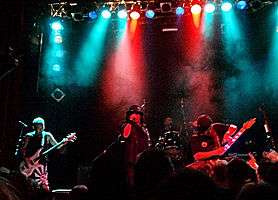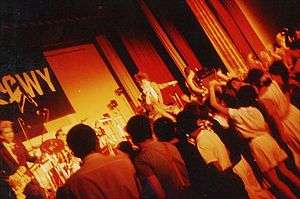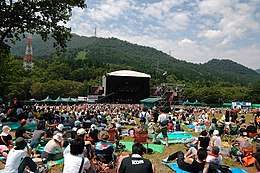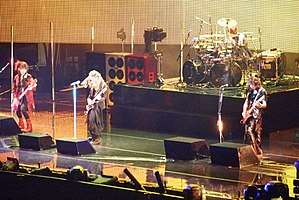Japanese rock
Japanese rock (Japanese: 日本のロック, Hepburn: Nihon no Rokku), sometimes abbreviated to J-rock (ジェイ・ロック, Jei Rokku), is rock music from Japan. Influenced by American and British rock of the 1960s, the first rock bands in Japan performed what is called Group Sounds, with lyrics almost exclusively in English. Folk rock band Happy End in the early 1970s are credited as the first to sing rock music in the Japanese language. Punk rock bands Boøwy and The Blue Hearts and hard rock/heavy metal groups X Japan and B'z led Japanese rock in the late 1980s and early 1990s by achieving major mainstream success.[1]
Japanese rock music has received recognition worldwide, being widely known in Asia, and has survived through decades competing with its contemporary local style J-pop. Rock bands such as B'z and Mr. Children are among the best selling music acts in Japan. The demand for rock in Japan is so huge that festivals mainly focused on it like the Fuji Rock Festival have been introduced since the late 90s with attendances reaching a peak of 200,000 people per festival making it the largest outdoor music event in the country.[2]
History
1960s: Western music adaptation

In the 1960s, many Japanese rock bands were influenced by Western rock musicians such as the Beatles, Bob Dylan, and the Rolling Stones,[3] along with other Appalachian folk music, psychedelic rock, mod and similar genres: a phenomenon that was called Group Sounds (G.S.). John Lennon of the Beatles later became one of the most popular Western musicians in Japan.[4] Group Sounds is a style of Japanese rock music that was popular in the mid to late 1960s. After the boom of Group Sounds, there were several influential singer-songwriters. Nobuyasu Okabayashi was the first who became widely recognized. Wataru Takada, inspired by Woody Guthrie, also became popular.. They both were influenced by American folk music but wrote Japanese lyrics. Takada used modern Japanese poetry as lyrics, while Kazuki Tomokawa made an album using Chuya Nakahara's poems. Tomobe Masato, inspired by Bob Dylan, wrote critically acclaimed lyrics. The Tigers were the most popular Group Sounds band in the era. Later, some of the members of the Tigers, the Tempters, and the Spiders formed the first Japanese supergroup, Pyg.
After seeing a show by then-upcoming artist Jimi Hendrix during a visit to Europe, Yuya Uchida returned home and formed Yuya Uchida & the Flowers in November 1967 in order to introduce a similar sound to Japan.[5] They released the album Challenge! in July 1969, featuring covers of American and British psychedelic rock acts such as Big Brother and the Holding Company and Cream.
1970s to 1980s: Diversification
Hard rock and heavy metal

Uchida replaced every member of The Flowers except its drummer and renamed them the Flower Travellin' Band for October 1970's Anywhere, which includes covers of heavy metal band Black Sabbath and progressive rock act King Crimson.[6] They moved to Canada and published their first album of original material,[7] Satori which was released in April 1971 and is now considered a progenitor of heavy metal music and,[8] together with Kirikyogen, doom metal.[9] Japanese heavy metal bands started emerging in the late 1970s, pioneered by Bow Wow (1975), 44 Magnum (1977) and Earthshaker (1978). In 1977, Bow Wow supported Aerosmith and Kiss on their Japanese tours.[10] They performed at both the Montreux Jazz Festival in Switzerland and the Reading Festival in England in 1982. After some member changes resulted in a more commercial sound, they changed their name to Vow Wow and relocated to England.[10] Their 1989 album Helter Skelter reached number 75 on the UK Albums Chart.[11]
In the 1980s, a plethora of Japanese heavy metal bands formed. Loudness was formed in 1981 by former Lazy members Akira Takasaki and Munetaka Higuchi. In 1983, they toured the United States and Europe and soon started focusing more on an international career. In a 1985 deal with Atco Records, Loudness became the first Japanese metal act signed to a major label in the United States.[12] Their albums Thunder in the East (1985), Lightning Strikes (1986) and Hurricane Eyes (1987) reached numbers 74, 64 and 190 on the Billboard chart.[13][14] Loudness replaced singer Minoru Niihara with American vocalist Michael Vescera in 1988,[15] in an unsuccessful attempt to further their international popularity. Till the end of the eighties only two other bands, Ezo and Dead End, got their albums released in the United States. In the eighties few bands had a female members, like all-female band Show-Ya fronted by Keiko Terada, and Terra Rosa with Kazue Akao on vocals. In September 1989, Show-Ya's album Outerlimits was released, it reached number 3 in the Oricon album chart.[16]
Folk
Homegrown Japanese folk rock had developed by the late 1960s. Happy End are credited as the first rock band to sing in the Japanese language.[17] Their self-titled debut album was released in August 1970 on the experimental record label URC (Underground Record Club).[18] This album marked an important turning point in Japanese music history, as it sparked what would be known as the "Japanese-language Rock Controversy" (ja:日本語ロック論争, Nihongo Rokku Ronsō). There were highly publicized debates held between prominent figures in the rock industry, most notably the members of Happy End and Yuya Uchida, regarding whether Japanese rock music sung entirely in Japanese was sustainable. The success of Happy End's debut album and their second, Kazemachi Roman released in November 1971, proved the sustainability of Japanese-language rock music in Japan.[19]
The Okinawan band Champloose, along with Carol (led by Eikichi Yazawa), RC Succession and Shinji Harada were especially famous and helped define the sound. Sometimes also beginning in the late sixties, but mostly active in the seventies, are musicians mixing rock music with American-style folk and pop elements, usually labelled "folk" by the Japanese because of their regular use of the acoustic guitar. This includes bands like Off Course, Tulip, Alice (led by Shinji Tanimura), Kaguyahime, Banban, Garo and Gedō. Solo artists of the same movement include Yosui Inoue, Yuming, and Iruka. Later groups, like Kai Band (led by Yoshihiro Kai) and early Southern All Stars, are often attached to the same movement.
Experimental and electronic

Several Japanese musicians began experimenting with electronic rock in the early 1970s. The most notable was the internationally renowned Isao Tomita, whose 1972 album Electric Samurai: Switched on Rock featured electronic synthesizer renditions of contemporary rock and pop songs.[20] Other early examples of electronic rock records include Inoue Yousui's folk rock and pop rock album Ice World (1973) and Osamu Kitajima's progressive psychedelic rock album Benzaiten (1974), both of which involved contributions from Haruomi Hosono,[21][22] who later started the electronic music group "Yellow Magic Band" (later known as Yellow Magic Orchestra) in 1977.[23] Most influentially, the 1970s spawned the electronic music band Yellow Magic Orchestra, led by Haruomi Hosono.
1980s to 1990s
Punk, original band boom

Early examples of Japanese punk rock include SS, the Star Club, the Stalin, Inu, Gaseneta, Bomb Factory, Lizard (who were produced by the Stranglers) and Friction (whose guitarist Reck had previously played with Teenage Jesus and the Jerks before returning to Tokyo) and the Blue Hearts. The early punk scene was immortalized on film by Sogo Ishii, who directed the 1982 film Burst City featuring a cast of punk bands/musicians and also filmed videos for The Stalin. In the 1980s, Japanese hardcore bands such as GISM, Gauze, Confuse, Lip Cream and Systematic Death began appearing, some incorporating crossover elements. The independent scene also included a diverse number of alternative/post-punk/new wave artists such as Aburadako, P-Model, Uchoten, Auto-Mod, Buck-Tick, Guernica and Yapoos (both of which featured Jun Togawa), G-Schmitt, Totsuzen Danball, and Jagatara, along with noise/industrial bands such as Hijokaidan and Hanatarashi.
In the 1980s, acts such as Boøwy inspired what is called the "Band Boom" (バンドブーム, Bando Būmu), popularizing the formation of rock groups.[24] In 1980, Huruoma and Ry Cooder, an American musician, collaborated on a rock album with Shoukichi Kina, driving force behind the aforementioned Okinawan band Champloose. They were followed by Sandii & the Sunsetz, who further mixed Japanese and Okinawan influences. Alternative rock bands like Shonen Knife, Boredoms and The Pillows formed. Nirvana's Kurt Cobain admitted to be a fan of Shonen Knife during the girls' tour in the LA in 1991. Cobain later asked the band to join them in a tour in the U.S. to which Shonen Knife accepted.[25][26]
Visual kei
.jpg)
Also during the 1980s, Japanese metal and rock bands gave birth to the movement known as visual kei. Taking visual influence from Western glam rock and glam metal, it was pioneered by bands like X Japan, Dead End, Buck-Tick, D'erlanger, and Color. Although starting in the early 1980s, it was not until the tail-end of the decade that visual kei acts saw major success. Buck-Tick's 1988 album Seventh Heaven reached number 3 on the Oricon chart, and its follow-ups Taboo (1989) and Aku no Hana (1990) both topped it.[27]
In April 1989, X Japan's second album Blue Blood reached number 6 and has sold 712,000 copies.[28] Their third and best-selling album Jealousy was released in July 1991, topped the charts and sold over 1 million copies.[28] They released two more number one studio albums, Art of Life (1993) and Dahlia (1996), before disbanding in 1997. X Japan actually signed an American record deal with Atlantic Records in 1992, but an international release never happened.[29] In the 1990s, Luna Sea and Glay sold millions of records, while Malice Mizer, La'cryma Christi, and Siam Shade also found success.
1990s to 2000s: Peak and later developments
In the 1990s, Japanese rock musicians such as B'z, Mr. Children, Glay, Southern All Stars, L'Arc-en-Ciel, Tube, Spitz, Wands, T-Bolan, Judy and Mary, Asian Kung–Fu Generation, Field of View, Deen, Ulfuls, Lindberg, Sharam Q, the Yellow Monkey, the Brilliant Green and Dragon Ash achieved great commercial success. B'z is the best selling artist in Japan with over 86 million confirmed records sold[30] and they are speculated to have sold 100 million worldwide.[31] The duo are also the first Asian band to be inducted in the Hollywood's RockWalk.[32]
In the 1990s, pop songs were often used in films, anime, television advertisement and dramatic programming, becoming some of the best-selling forms of music in Japan. The rise of disposable pop has been linked with the popularity of karaoke, leading to criticism that it is consumerist: Kazufumi Miyazawa of the Boom said "I hate that buy, listen, and throw away and sing at a karaoke bar mentality." Of the visual kei bands, Luna Sea, whose members toned down their on-stage attire with on-going success, was very successful, while Malice Mizer, La'cryma Christi, Shazna, Janne Da Arc, and Fanatic Crisis also achieved commercial success in the late 1990s. Ska-punk bands of the late nineties extending in the years 2000 include Shakalabbits and 175R.

The first Fuji Rock Festival opened in 1997. The following year, Supercar released its influential debut album Three Out Change.[33] Characterized as having "almost foundational importance to 21st century Japanese indie rock",[34] Supercar remained active through 2005 with their later albums containing more electronic rock.
Around the same time, bands such as Quruli and Number Girl had begun heavily influencing Japanese alternative rock. Music critic Ian Martin wrote that, along with Supercar, these groups had demonstrated that "Japanese rock bands could take on the British and American alternative bands of the 90s at their own game ... and in doing so, they had laid new ground for Japanese rock to develop in its own way from this point on."[35]
Rising Sun Rock Festival opened in 1999. Summer Sonic Festival and Rock in Japan Festival opened in 2000. Though the rock scene in the 2000s is not as strong, newer bands such as Bump of Chicken, ONE OK ROCK, Sambomaster, Flow, Orange Range, Remioromen, Uverworld, Radwimps, and Aqua Timez, which are considered rock bands, have achieved success. Orange Range also adopts hip hop. Established bands as B'z, Mr. Children, Glay, and L'Arc-en-Ciel also continue to top charts, though B'z and Mr. Children are the only bands to maintain a high standards of their sales along the years.
Japanese rock has a vibrant underground rock scene,[36] best known internationally for noise rock bands such as Boredoms and Melt Banana, as well as stoner rock bands such as Boris and alternative acts such as Shonen Knife (who were championed in the West by Kurt Cobain), Pizzicato Five, and the Pillows (who gained international attention in 1999 for the FLCL soundtrack). More conventional indie rock artists such as Eastern Youth, the Band Apart and Number Girl have found some success in Japan, but little recognition outside of their home country. Other notable international touring indie rock acts are Mono and Nisennenmondai.
The 2010s
New band boom, further overseas recognition

During the late 2000s there was an increasing number of bands that had built up a strong fan base prior to their main break-through in the music industry. Indie band flumpool sold over one million copies of their first digital single 'Hana ni nare'. Sakanaction made their first live concert at Nippon Budokan while enjoying major success with their singles "Aruku Around" and "Rookie". Sakanaction was pinned as a different type of band since they experimented with electronic music and synthrock. Other bands that have gone mainstream included Gesu no Kiwami Otome, Sekai no Owari and Alexandros. Because of the sudden major increase on indie bands and rock bands in general that compete with contemporary J-Pop artists, the movement has been referred to as a band boom by the media and has been praised as a change to the Japanese music in general. Since these bands don't rely in a very heavy sound but take a softer, catchier approach, they have been proved to be more appealing to pop fans that are not familiar with rock.[38][39][40]
Veteran rock bands like L'Arc~en~Ciel and X Japan soldout concerts at Madison Square Garden in 2012 and 2014 respectively among other large arenas through the United States. One Ok Rock performed at the Taipei Arena being the first time a Japanese band did so and additionally sold-out shows at the AsiaWorld-Arena and Mall of Asia Arena, these two being the largest overseas shows they had to date with an average attendance of 12,000 people at each concert.[41][42][43] Slap-guitarist Miyavi, who has his roots in visual kei, has toured worldwide extensively since 2008, when his This Iz The Japanese Kabuki Rock Tour 2008 tour covered a distance of approximately 48,385 miles, equivalent to almost two trips around the world, and the majority of the concerts were sold out and covered extensively by media organizations. It was the most successful international tour undertaken by a Japanese artist in history.[44] As of 2015, Miyavi has performed at 250 concerts in more than 30 countries around the world.[45]
Girls Metal Band Boom
The decade is seeing a "Girls Metal Band Boom" (ガールズ・メタル・バンド・ブーム), with a large number of all-female heavy metal bands forming and gaining mainstream attention. Although not the first to form, Aldious have been cited as the initiators of the movement when their debut album Deep Exceed (2010) topped the Oricon Indies Albums Chart and reached number 15 on the main chart.[46][47][48] Another notable girls metal band is Cyntia, who are believed to be the first of the movement to sign to a major record label when they joined Victor Entertainment in 2013.[49]
The year 2014 brought the international success of self-described "kawaii metal" idol act Babymetal, through the viral YouTube hit "Gimme Chocolate!!". They were the opening act to five of Lady Gaga's concerts on her ArtRave: The Artpop Ball 2014 tour.[50] In 2016, Babymetal began a world tour at London's Wembley Arena, becoming the first Japanese act to headline the venue, and their album Metal Resistance reached number 15 on the UK Albums Chart, marking the highest ever entry by a Japanese act.[51][52] They also made their US television debut by performing "Gimme Chocolate!!" on The Late Show with Stephen Colbert.[53]
Band-Maid earned worldwide attention circa 2015 for their "submissive" maid appearance contrasting with their aggressive music.[54][55] They began international activities the following year, including signing to JPU Records.[55] In 2018, Lovebites won the Metal Hammer Golden Gods Awards for Best New Band and became the first Japanese all-female heavy metal band to perform at Germany's Wacken Open Air.[56][57]
References
- "What replaced the 80s band boom? 3 critics talk on 'Japanese adolescent rock. (in Japanese)". Real Sound.jp. 2015-12-22. Retrieved 2016-01-26.
- Martin, Ian (July 26, 2015). "Rock in Japan focuses on the experience of an eternal afternoon". The Japan Times. Retrieved February 23, 2016.
- ?????????????! ?????????????? (in Japanese). Oricon. 2006-06-21. Retrieved 2009-01-09.
- "Japan keeps Lennon's memory alive". BBC. 2008-12-08. Retrieved 2009-03-10.
- "Yuya Uchida Discography". uchidayuya.com. Retrieved 2016-02-24.
- "Anywhere - The Flower Travellin' Band". Allmusic. Retrieved 2016-04-20.
- "We just stopped, took a break. It turned out to be for 36 years!". jrawk.com. Archived from the original on 2009-01-01. Retrieved 2016-02-03.
- Fitzpatrick, Rob (2013-06-05). "The 101 strangest records on Spotify: Flower Travellin' Band – Satori". The Guardian. Retrieved 2016-04-20.
- "Review: Flower Travellin Band - Satori". Sputnikmusic. 2013-05-15. Retrieved 2016-04-20.
- "Kyoji Yamamoto leaves all inhibitions behind". The Japan Times. 2009-04-18. Retrieved 2016-04-20.
- "VOW WOW". Official Charts Company. Retrieved 2016-04-20.
- "Loudness: Minoru Niihara looks back at "Thunder in the East" album". Roppongi Rocks. 2015-09-22. Retrieved 2016-04-20.
- Top Pop Albums; May 18, 1985. Billboard. p. 72.
- "Loudness - Chart History". Billboard. Retrieved 2016-04-20.
- "UNITED – Thirty Years Of Thrash And Burn". carlbegai.com. 2011-12-23. Retrieved 2016-04-20.
- "Outerlimits Oricon chart" (in Japanese). Oricon. Retrieved 12 September 2010.
- "Top 100 Japanese pops Artists - No.4". HMV Japan (in Japanese). 2003-11-27. Retrieved 2016-02-04.
- "Happy End". Japrocksampler. Retrieved 2013-04-25.
- TJ Mook Kike! Densetsu no Nihon Rokku 1969-79 TJ MOOK 聴け! 伝説の日本ロック1969-79 [TJ Mook Kike! Legendary Japanese Rock 1969-79]. Takarajima Press. 2004. p. 33. ISBN 4-7966-3862-8.
- Mark Jenkins (2007), Analog synthesizers: from the legacy of Moog to software synthesis, Elsevier, pp. 133–4, ISBN 0-240-52072-6, retrieved 2011-05-27
- 井上陽水 – 氷の世界 at Discogs (Translation)
- Osamu Kitajima – Benzaiten at Discogs
- Harry Hosono And The Yellow Magic Band – Paraiso at Discogs
- "Rocker Hotei hears London calling". The Japan Times. 2012-06-14. Retrieved 2013-04-27.
- Prato, Greg. "Shonen Knife – Biography". Allmusic. Macrovision Corporation. Retrieved 2009-03-16.
- SUMMER SONIC 08 LIVE REPORT Archived 2016-08-24 at the Wayback Machine
- "BUCK-TICKのアルバム売り上げランキング" (in Japanese). oricon.co.jp. Retrieved 2012-01-29.
- "X、初期のリマスター再発商品2作が好調!" (in Japanese). Oricon. 2007-02-14. Retrieved 2016-04-20.
- Strauss, Neil (1998-06-18). "The Pop Life: End of a Life, End of an Era". The New York Times. Retrieved 2016-04-20.
- Yang, Jeff (September 8, 2005). "ASIAN POP Hello Kitty! Rock! Rock!". San Francisco Chronicle. Retrieved April 23, 2014.
- "B'z got their 22nd No. 1 album, ranked No.1 in history and dominates all the 6 main ranking sections" (in Japanese). Oricon. 2008-06-24. Archived from the original on 16 October 2008. Retrieved 2008-11-14.
- "Duo B'z enters L.A. Rockwalk". The Japan Times. 2007-11-21. Retrieved 2008-11-14.
- Martin, Ian (October 4, 2017), "Supercar's 'Three Out Change!!' may be the most stunning debut in Japanese rock history", The Japan Times
- Martin, Ian (May 17, 2019), "Supercar's Futurama", Metropolis
- Martin, Ian F. (2016). Quit Your Band: Musical Notes From the Japanese Underground. Awai Books. p. 26. ISBN 978-1-937220-05-1.
- Martin, Ian F. (2016). Quit Your Band: Musical Notes From the Japanese Underground. Awai Books. p. 130. ISBN 978-1-937220-05-1.
- "L'Arc-en-Ciel, Japanese Visual Rock Band, To Play Madison Square Garden This Weekend". Billboard. 2012-03-23. Retrieved 2016-03-27.
- "Why is Gesu no Kiwami Otome popular? Is there going to be another "BAND BOOM" with the rise of the new generation?". Arama Japan. 2015-10-20. Retrieved 2016-01-29.
- Chouseisan (2015-11-18). "2015 year of the Band Boom?". Recruit Holdings Inc. Retrieved 2016-01-27.
- Ryutaro Aoki (2015), Gesu tapped into the 2015 band boom, The Japan Times
- Apple Daily (2016), ONE OK ROCK嗨唱 搖滾撼動小巨蛋, Apple Daily (Taiwan)
- Ajt Santos (2016), One OK Rock is a true class act we can’t wait to see again, Philippine Daily Inquirer
- Steven Lavoie (2016), One OK Rock thrills Manila, Rappler
- Jon Wilks (2011-01-19). "Miyavi: Artist, family man, delight to the nostrils". Time Out Tokyo. Archived from the original on May 1, 2014. Retrieved May 2, 2014.
- "Japan's Miyavi says Nashville infuses his latest CD". Yahoo/Reuters. 2015-09-28. Retrieved 2017-03-19.
- "アルディアス、Marina加入". barks.jp (in Japanese). Retrieved 2016-04-20.
- "The DESTROSE Connection ~The Prologue~". jame-world.com. Retrieved 2016-04-19.
- "Aldiousのアルバム売り上げランキング". Oricon (in Japanese). Retrieved 2016-04-20.
- "Cyntia". jame-world.com. Retrieved 2017-04-17.
- "BABYMETAL レディー・ガガの米ツアーに大抜擢、LAワンマンも". Billboard Japan (in Japanese). 2014-06-17. Retrieved 2016-04-20.
- "BABYMETAL、宙を舞う! 新曲連打、大発表続々で燃えた横浜アリーナ公演レポート!". Rockin'On Japan (in Japanese). 2015-12-14. Retrieved 2016-04-20.
- "Babymetal break 2 UK records". Metal Hammer. 2016-04-05. Retrieved 2016-05-15.
- "The Late Show with Stephen Colbert Video - BABYMETAL Makes Their U.S. Television Debut - CBS.com". CBS. CBS Interactive. Archived from the original on 2016-04-21. Retrieved 2016-04-23.
- ""Thrill" to the Sounds of Japanese Girl Band Band-Maid — Video". Guitar World. 2015-07-01. Retrieved 2018-03-11.
- "Who are Band-Maid and what do they want?". Teamrock.com. 2016-08-30. Retrieved 2017-01-11.
- "LOVEBITES Named Best New Band at The Metal Hammer Golden Gods Awards 2018". JaME World. 2018-06-12. Retrieved 2018-06-12.
- "LOVEBITES Confirmed for Wacken Open Air 2018". JPU Records. Retrieved 2018-02-25.